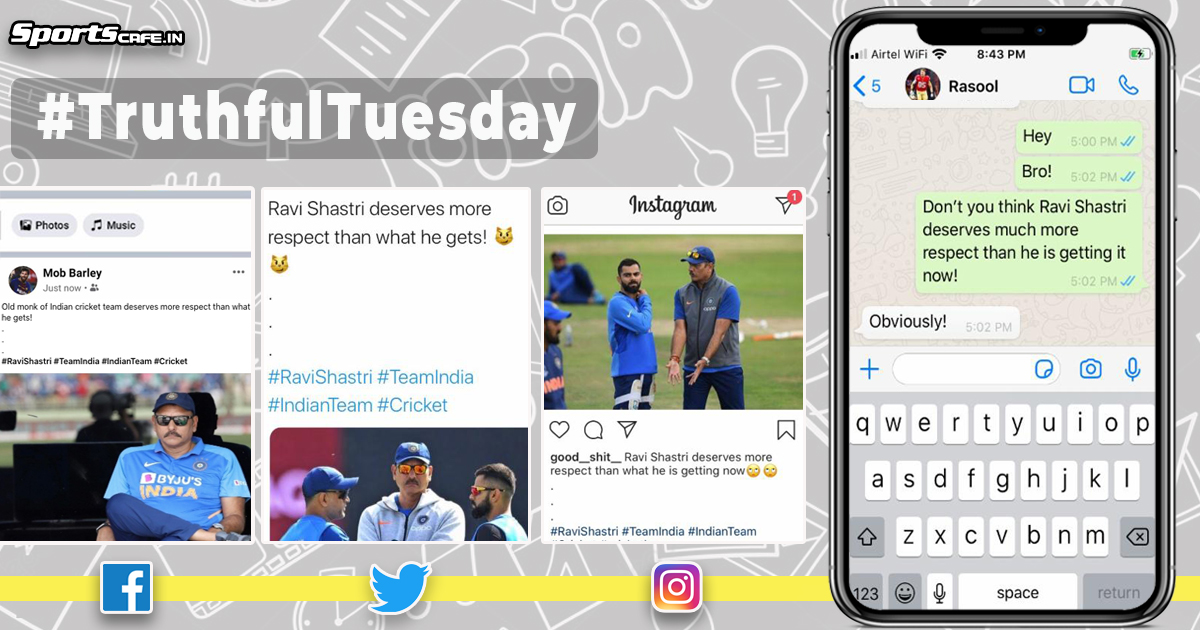Truthful Tuesday | Ridiculed Ravi Shastri deserves more respect than what he gets
Who do you think is behind the brand of cricket that team India plays? Many would say Kohli, but think again. Ravi Shastri, the tracer bullet of Indian cricket, has certainly shaped the way India has played cricket, which also has helped them build a team that is no longer inferior away from home.

Since the fiasco in 2017, when Virat Kohli reportedly could not come to terms with the then coach and tactician, Anil Kumble, India was in the dire need of a coach who could be in line with Kohli’s aggression. While there were at least four other candidates for the post, it was announced that the 2014 team director for the tour of England, Ravi Shastri, would take over the job.
The job came with a lot of expectations and a lot of repairs, with the Indian team having just lost the 2017 Champions Trophy final against Pakistan. All the responsibility sat comfortably at the shoulder of one of India’s yesteryear poster-boy, who was, prior to the stint, known for his commentary. His appointment was highly controversial due to rumours which indicated that Kohli wanted a ‘yes’ man in his team. But truth be spoken, in no way was the selection done on the back of the skipper’s opinion, with the Cricket Advisory Committee (CAC) taking their stand on the selection, with them coming to the conclusion that Shastri was the right man to lead the Indian cricket into the future.
Shastri’s first stint in the Indian team was a mixed bag - he was definitely the poster boy of the country, thanks to his all-round skills, but his attitude was far behind the others. In the 80s and 90s, the Mumbaikar was a hard-boiled competitor with a fierce-attitude and a heartthrob-like personality. However, over the years, his personality has changed from being a competitor to being a person who was reduced to the memes section of social media. For the first time in his career, his attitude was not questioned. Rather, it was his ability and credentials to be at the helm that came under scrutiny. Was Shastri a ‘yes’ man during his playing days? Well, he would do anything for the country, starting from opening the innings to batting as low as No.10.
The 58-year-old was oddly from an era, where being silent and determined was the only way you could win a place in the Indian team. But he was starkly different from the lot, chirpy yet at the same time possessing the skills to outdo one and all on the field. When he took over the ‘team manager’ role for the first time in his career, it was when the Indian cricket was having one of its darkest days - post the 2007 Cricket World Cup. He led the side, took them by the scruff of their neck and brought them back to reality, putting them on course to the 2011 World Cup win. Yet, social media’s keyboard warriors yap and yap on how his coaching style is next to nothing, accusing him of spoiling the Indian team with his antics.
His second stint and its subsequent effect on the Indian team
When Anil Kumble was gone, why was Ravi Shastri one of the top favourites to take over the role? It was his stint in the 2014 England tour, where he was Team India’s team director in their whitewash at the hands of the hosts, which caught the eye of the board. So when he took over the reins in 2017, his role in the team was crystal clear - to elevate the Indian team’s status after failing all around the world in the previous few years.
First on the chart was to help Virat Kohli and co to shut down the tag of being ‘poor travellers,’ which essentially was given to the team following their losses away from home. Since Shastri taking over, India have now won a series away from home in Sri Lanka, West Indies and more importantly, Australia. Never has an Indian team come back from Down Under being the best side or even with the feeling of being the best of the two sides. When India won the 2018-19 series against Australia, all plaudits quickly went to how the team performed as a collective unit, totally neglecting the change in attitude that was brought forward by the Mumbaikar.
More importantly, if you look closely at the body language of the Australian team, it would tell you a different tale - one that has never existed before in the Kangaroos’ history. They were scared of this Indian team - both of the visitors’ batting prowess and their devastating bowling unit. After losing in Perth, two newbie openers - Mayank Agarwal and Hanuma Vihari - were sent into bat at a jam-packed MCG against the mighty Australians, almost as if to suggest that the side feared no one. If that was not a statement of intent, then I don’t know what is.
The results
On top of that, his coaching stint has also coincided with the debuts of several youngsters in the Indian dressing room - be it Hardik Pandya, Rishabh Pant, Prithvi Shaw or the budding figure of Mayank Agarwal. While his status as a coach in the shortest format is never in question, his ability to lead the side in the longest format has been one. While India have managed success away from home, their 4-1 loss against England and a 2-1 loss against South Africa has prompted the doubts.
His role was fairly simple - he had to build a team which was enough to sustain itself to the next generation, ensuring that a smooth transition takes place. A few cocky quotes here and there, be it after the Test series win over Australia or post the South Africa series, where he was an extravagant self of himself, were blown out of proportion. But, in reality, the quotes, where he stated that the future of the team was safe and secure, never took its shape or its identity in the mainstream media. He also talked about how he would help players, irrespective of their talent, in case they need a guiding light to help them improve their game. In its true sense, that is exactly what a coach needs to do - help the players when in need without allowing them to go under a stressful phase.
“Next two years is to see the smooth transition happening. You will get a lot of youngsters coming in, both white-ball setup and Tests. You need to identify another three-four bowlers to add to the pool by the end of our tenure. My endeavour by the end of this tenure would be to leave the team in a happier space so that they can set a legacy in the time to come. The reason why I came in here is the belief I had in this team, the belief that they could leave a legacy which very few teams have left behind which other teams going down will try and emulate,” he said.
In the 28 Tests that he has remained as India’s head coach thus far, he has led the team to victories in 18 of them, including the two Tests away in Australia, which was historic in every sense. In the 75 ODIs that he has been part of the team, Virat Kohli and co have won 51 of them, with a win/loss ratio of 2.550. In the T20s, 35 of them have been won with only 14 losses with Shastri as a coach.
His main role in the team was to develop an atmosphere, where there is no discrimination between the seniors and juniors, alongside building a team, which could sustain itself without any influence and truth be spoken, he has done it with elan. Despite all of this, Shastri has been highly ridiculed in the country, be it on social media platforms or by the media, in general, for his off-field behaviour. The man surely needs to be respected more, for the work he has done with the cricketers - be it the youngsters or the experienced ones.

Comments
Sign up or log in to your account to leave comments and reactions
0 Comments